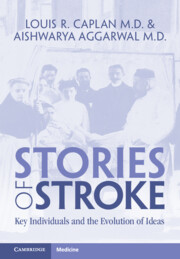Book contents
- Stories of Stroke
- Stories of Stroke
- Copyright page
- Contents
- Contributors
- Why This Book Needed to Be Written
- Preface
- Part I Early Recognition
- Part II Basic Knowledge, Sixteenth to Early Twentieth Centuries
- Part III Modern Era, Mid-Twentieth Century to the Present
- Types of Stroke
- Some Key Physicians
- Imaging
- Care
- Treatment
- Chapter Forty Three Clinical Stroke Trials
- Chapter Forty Four Heparin
- Chapter Forty Five Warfarin
- Chapter Forty Six Direct Oral Anticoagulants
- Chapter Forty Seven Aspirin
- Chapter Forty Eight Other Antiplatelets
- Chapter Forty Nine Other Medical Treatments
- Chapter Fifty Neuroprotection
- Chapter Fifty One Thrombolysis
- Chapter Fifty Two Treatment of Cerebral Venous Thrombosis
- Chapter Fifty three Recovery and Rehabilitation
- Chapter Fifty Four Carotid Artery Surgery
- Chapter Fifty Five Angioplasty and Stenting
- Chapter Fifty Six Endovascular Treatment of Acute Ischemic Stroke
- Chapter Fifty Seven Brain Aneurysm Treatment
- Chapter Fifty Eight Medical and Surgical Treatments of Intracerebral Hemorrhage
- Chapter Fifty Nine Treatment of Vascular Malformations
- Part IV Stroke Literature, Organizations, and Patients
- Index
- References
Chapter Fifty One - Thrombolysis
from Treatment
Published online by Cambridge University Press: 13 December 2022
- Stories of Stroke
- Stories of Stroke
- Copyright page
- Contents
- Contributors
- Why This Book Needed to Be Written
- Preface
- Part I Early Recognition
- Part II Basic Knowledge, Sixteenth to Early Twentieth Centuries
- Part III Modern Era, Mid-Twentieth Century to the Present
- Types of Stroke
- Some Key Physicians
- Imaging
- Care
- Treatment
- Chapter Forty Three Clinical Stroke Trials
- Chapter Forty Four Heparin
- Chapter Forty Five Warfarin
- Chapter Forty Six Direct Oral Anticoagulants
- Chapter Forty Seven Aspirin
- Chapter Forty Eight Other Antiplatelets
- Chapter Forty Nine Other Medical Treatments
- Chapter Fifty Neuroprotection
- Chapter Fifty One Thrombolysis
- Chapter Fifty Two Treatment of Cerebral Venous Thrombosis
- Chapter Fifty three Recovery and Rehabilitation
- Chapter Fifty Four Carotid Artery Surgery
- Chapter Fifty Five Angioplasty and Stenting
- Chapter Fifty Six Endovascular Treatment of Acute Ischemic Stroke
- Chapter Fifty Seven Brain Aneurysm Treatment
- Chapter Fifty Eight Medical and Surgical Treatments of Intracerebral Hemorrhage
- Chapter Fifty Nine Treatment of Vascular Malformations
- Part IV Stroke Literature, Organizations, and Patients
- Index
- References
Summary
Knowledge about thrombosis, the formation of clots, dates back to Virchow, who is discussed in Chapter 13. Perturbation of a vessel leads to release of a thrombokinase that catalyzes the transformation of a precursor protein prothrombin to thrombin. Thrombin, a clot-promoting protein, catalyzes the transformation of fibrinogen (another precursor protein) into fibrin. Fibrin provides the scaffolding that holds clots together. Clots are necessary for survival since they stem bleeding. Equally necessary are chemical reactions that dissolve clots. An “activator” converts plasminogen (another precursor protein) to plasmin, a powerful fibrin-dissolving, clot-dissolving enzyme. Tissue plasminogen activator (tPA) is the molecule in question. It has the special property of acting upon plasminogen only in the presence of fibrin, only where there is a clot. The process of breaking up clots is referred to as thrombolysis. Thrombolytic agents act by breaking up fibrin bridges within thrombi and, in doing so, allow blood to flow. The process is often referred to as fibrinolysis since fibrin is the main target. Fibrinolytic drugs degrade the fibrin network mesh of red erythrocyte-fibrin clots. The formation of thrombi in the body stimulates a natural fibrinolytic mechanism for thrombolysis. Plasmin is formed and its activity is concentrated at the sites of fibrin deposition. The ideal thrombolytic agent would adhere specifically to fibrin in clots and would not affect circulating fibrinogen. Lowering circulating fibrinogen levels excessively could promote bleeding.
- Type
- Chapter
- Information
- Stories of StrokeKey Individuals and the Evolution of Ideas, pp. 491 - 504Publisher: Cambridge University PressPrint publication year: 2022

